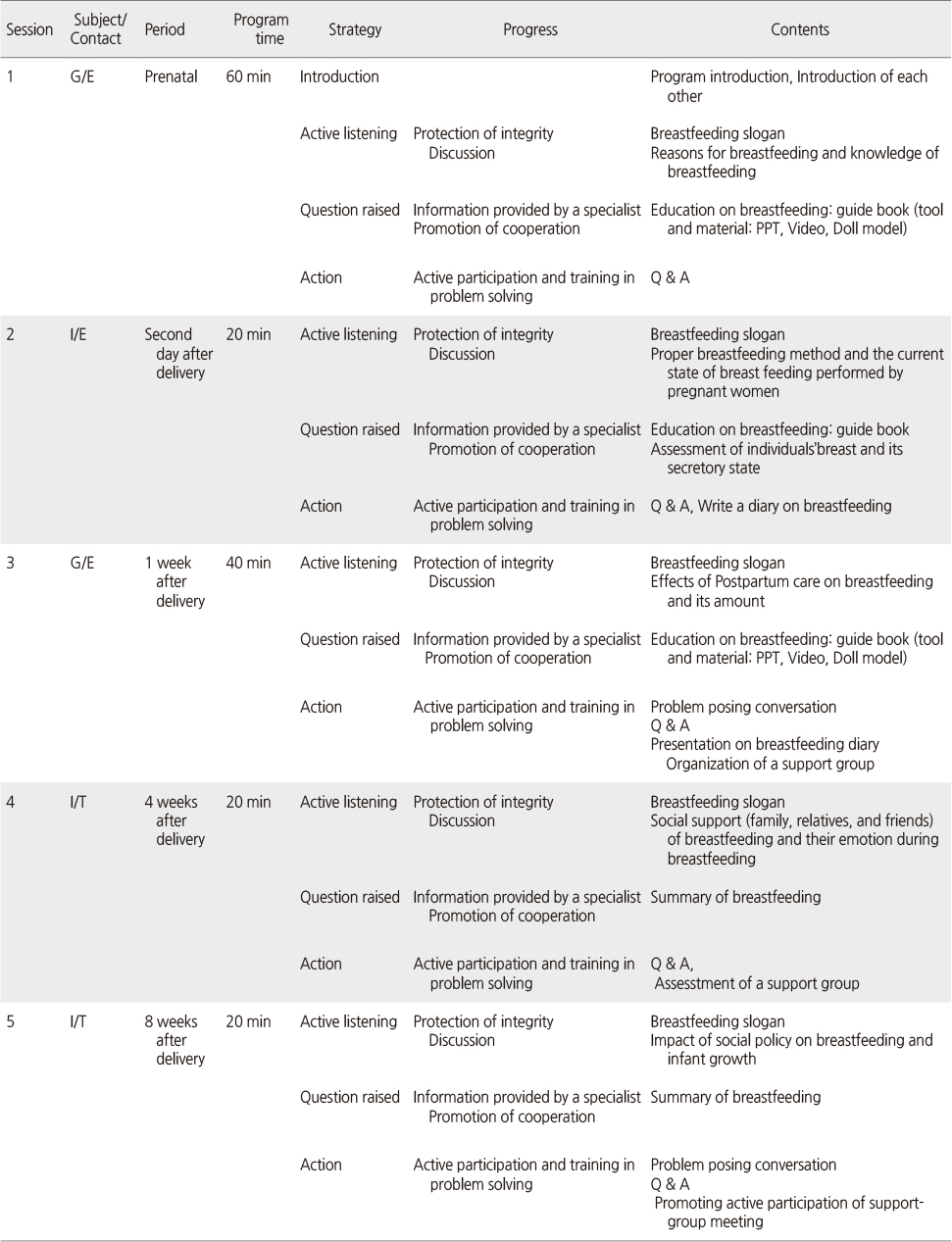Articles
- Page Path
- HOME > J Korean Acad Nurs > Volume 46(3); 2016 > Article
-
Original Article
- Effects of Breastfeeding Empowerment Program on Breastfeeding Self-efficacy, Adaptation and Continuation in Primiparous Women
- Seon Mi Song, Mi Kyung Park
-
Journal of Korean Academy of Nursing 2016;46(3):409-419.
DOI: https://doi.org/10.4040/jkan.2016.46.3.409
Published online: June 30, 2016
1Eden Hospital, Gwangju, Korea.
2Department of Nursing, Nambu University, Gwangju, Korea.
- Address reprint requests to: Park, Mi Kyung. Nambu University, Union Hall 7205, Chemdan Jungang-ro 23, Gwangsan-gu, Gwangju 62271, Korea. Tel: +82-62-970-0153, Fax: +82-62-970-0260, pmk0220@nambu.ac.kr
© 2016 Korean Society of Nursing Science
This is an Open Access article distributed under the terms of the Creative Commons Attribution NoDerivs License. (http://creativecommons.org/licenses/by-nd/4.0/) If the original work is properly cited and retained without any modification or reproduction, it can be used and re-distributed in any format and medium.
Figure & Data
REFERENCES
Citations

- Development and Effectiveness Evaluation of Comprehensive Mobile-Based, Breastfeeding Promotion Program for Mothers with Gestational Diabetes
Eunju Kwak, Seungmi Park
Journal of Korean Academy of Nursing.2024; 54(2): 224. CrossRef - The effectiveness of prenatal breastfeeding education on breastfeeding uptake postpartum: A systematic review
Jennifer Kehinde, Claire O'Donnell, Annmarie Grealish
Midwifery.2023; 118: 103579. CrossRef - Effectiveness of distance education program on mothers’ empowerment in exclusive breastfeeding
Zeynab Taheri, Fatemeh Bakouei, Mouloud Agajani Delavar, Mahbobeh Faramarzi, Afsaneh Bakhtiari, Fatemeh Nasiri Amiri
Journal of Education and Health Promotion.2022; 11(1): 420. CrossRef - Social policies and breastfeeding duration in South Korea: A survival analysis of the national data
Jung Hee Yeo, Eun-Young Kim
Midwifery.2022; 107: 103282. CrossRef - A Structural Model for Breastfeeding Behavior of First-Time Mothers
Seol Hui Park, Seang Ryu
Journal of The Korean Society of Maternal and Child Health.2021; 25(3): 184. CrossRef - Development and Evaluation of the Parenting Support Group Program for Mothers with Infants
Sun Hwa Park, Kyung Ja June
Journal of Korean Academy of Community Health Nursing.2021; 32(1): 40. CrossRef - Breastfeeding Adaptation Scale-Short Form for mothers at 2 weeks postpartum: construct validity, reliability, and measurement invariance
Sun-Hee Kim
Korean Journal of Women Health Nursing.2020; 26(4): 326. CrossRef - Knowledge of and Attitude toward Breastfeeding among Medical Staff Working in the Neonatal Intensive Care Unit and Obstetric Unit
Eun Sook Kim, Young Hee Cho, Hyejung Lee
Journal of The Korean Society of Maternal and Child Health.2020; 24(2): 102. CrossRef - Knowledge and health beliefs about gestational diabetes and healthy pregnancy's breastfeeding intention
Seungmi Park, Jung Lim Lee, Jang In Sun, Youngji Kim
Journal of Clinical Nursing.2018; 27(21-22): 4058. CrossRef
Breastfeeding Empowerment Program
G=Group; I=Individual; E=Meeting; T=Telephone.
Homogeneity Test of General Characteristics (N=55)
Exp.=Experimental group; Cont.=Control group.
Homogeneity Test for Obstetrical, Breastfeeding Characteristics and Breastfeeding Self-efficacy (N=55)
*Fisher's exact test; Exp.=Experimental group; Cont.=Control group.
Comparison of Breastfeeding Self-efficacy and Adaptation between Groups (N=55)
Exp.=Experimental group; Cont.=Control group.
Comparison of Breastfeeding Continuation between Groups (N=55)
*Fisher's exact test; Exp.=Experimental group; Cont.=Control group.
G=Group; I=Individual; E=Meeting; T=Telephone.
Exp.=Experimental group; Cont.=Control group.
*Fisher's exact test; Exp.=Experimental group; Cont.=Control group.
Exp.=Experimental group; Cont.=Control group.
*Fisher's exact test; Exp.=Experimental group; Cont.=Control group.
 KSNS
KSNS
 E-SUBMISSION
E-SUBMISSION





 Cite
Cite

